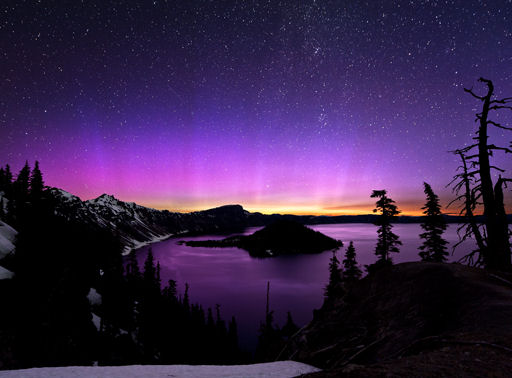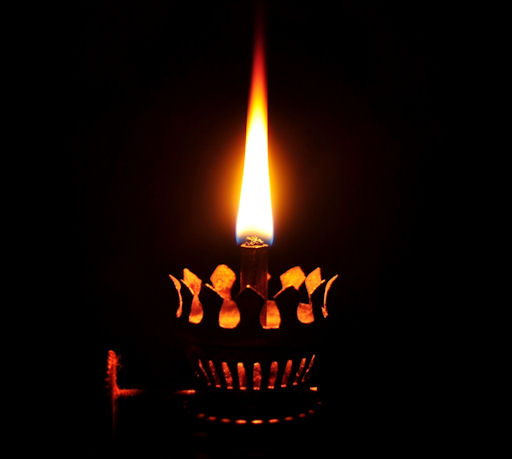TAIKONAUTS IN SPACE: China's march into space is quickening. On June 15th, the Chinese space agency launched the Shenzhou 9 spacecraft with three taikonauts on board. One of them, fighter pilot Liu Yang, is the first Chinese woman in space. The Shenzhou 9 is scheduled to dock with China's Tiangong 1 space station later today. Check the Simple Satellite Tracker or your smartphone for sighting opportunities.
SUBSIDING STORM: A geomagnetic storm that began on June 16th when a double CME hit Earth's magnetic field is finally subsiding. At the height of the disturbance on June 17th, Northern Lights descended as far south in the USA as Michigan, Wisconsin, Minnesota, Iowa, Utah, Maryland, Nebraska, Washington, and the Dakotas. Brad Goldpaint sends this picture from Crater Lake, Oregon:
Although the storm is mostly over, it could re-ignite as magnetic knots in the wake of the CME drift past Earth. NOAA forecasters estimate a 40% chance of more high-latitude geomagnetic storms during the next 24 hours. Aurora alerts: text, voice.
Realtime Space Weather Photo Gallery
FIRE LIT BY THE TRANSIT OF VENUS: Around the world on June 5th and 6th, millions of people watched the Transit of Venus. Only one man used it to light a candle. Christopher Handler of Adelaide, South Australia, explains how it was done: "The flame that burns in this lantern was lit with photons of light, of which about 0.001% had skipped through the atmosphere of another planet." (continued below)
"While watching the transit with my wife and son, I began to write words on a piece of wood with a magnifying glass, while explaining to my son that some of the sunshine we were using had bounced off the clouds of Venus only minutes earlier. Before long, we had lit a small fire in some kindling and from that lit several candles around the house. The hours passed by and the transit was over, yet we still have the flame. Captivated by the thought that it will take another 105 years before it could be done on Earth again, I feel almost compelled to keep it alight, even now, many days later."
A thousand more unique photos of the event may be found in the Transit of Venus gallery. Note: When you're browsing the gallery, please vote for your favorite images. We'll be creating a gallery of the most popular shots--and your votes count.

![]()
Solar wind
speed: 436.2 km/sec
density: 1.3 protons/cm3
explanation | more data
Updated: Today at 1526 UT
![]()
X-ray Solar Flares
6-hr max: B6 1047 UT Jun18
24-hr: C1 0059 UT Jun18
explanation | more data
Updated: Today at: 1500 UT
![]()
![]()
![]()
Daily Sun: 18 Jun 12
![]()
![]()
Sunspot 1504 is decaying and poses a declining threat for strong M-class solar flares. Credit: SDO/HMI
![]()
![]()
![]()
Sunspot number: 96
What is the sunspot number?
Updated 17 Jun 2012
Spotless Days
Current Stretch: 0 days
2012 total: 0 days (0%)
2011 total: 2 days (<1%)
2010 total: 51 days (14%)
2009 total: 260 days (71%)
Since 2004: 821 days
Typical Solar Min: 486 days
Updated 17 Jun 2012
The Radio Sun
10.7 cm flux: 124 sfu
explanation | more data
Updated 17 Jun 2012
![]()
![]()
![]()
Current Auroral Oval:
![]()
Switch to: Europe, USA, New Zealand, Antarctica
Credit: NOAA/POES
![]()
![]()
![]()
Planetary K-index
Now: Kp= 2 quiet
24-hr max: Kp= 5 storm
explanation | more data
![]()
Interplanetary Mag. Field
Btotal: 3.7 nT
Bz: 2.1 nT south
explanation | more data
Updated: Today at 1526 UT
![]()
![]()
![]()
Coronal Holes: 18 Jun 12
![]()
![]()
There are no large coronal holes on the Earthside of the sun. Credit: SDO/AIA.






